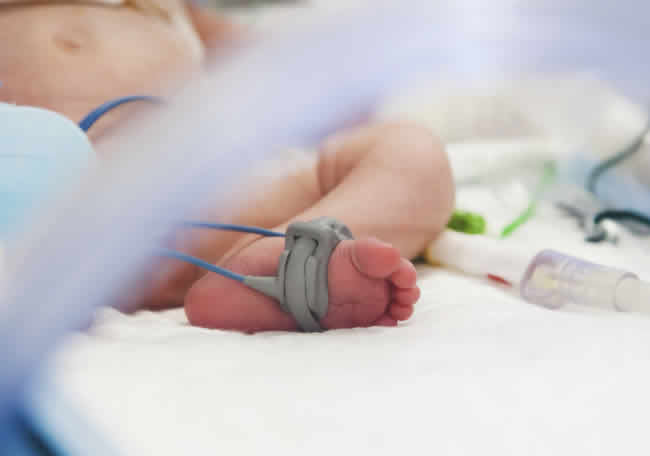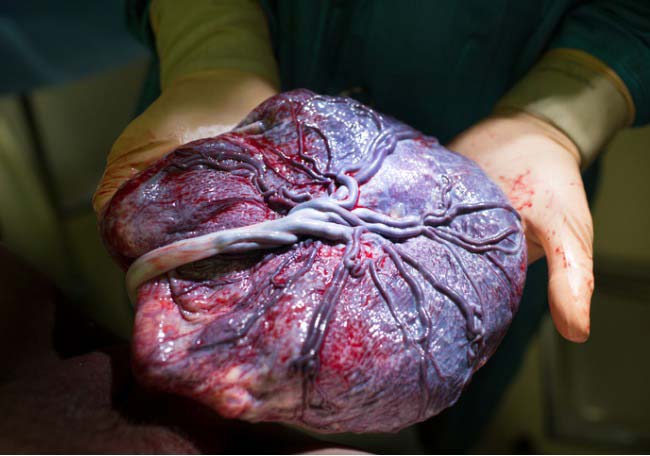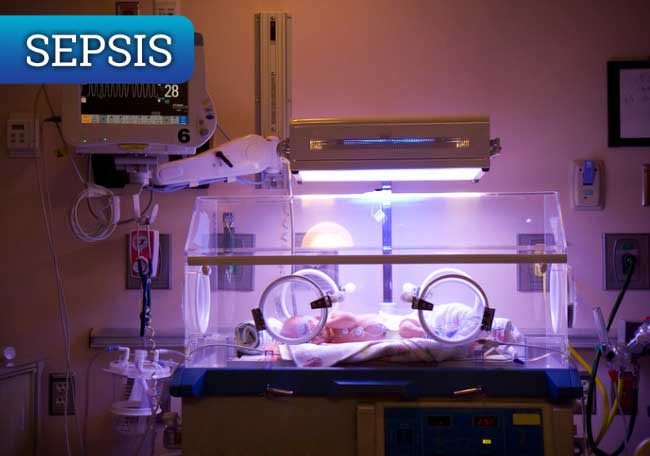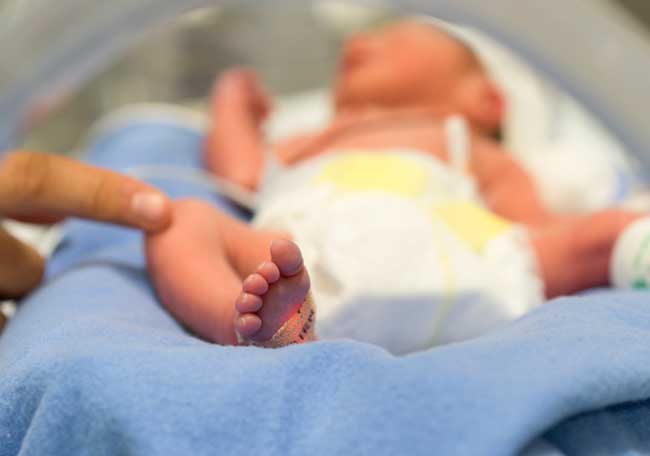Niños en riesgo de enfermedad por Estreptococo grupo B

. Centers for Disease Control and Prevention. Prevention of perinatal group B streptococcal disease: a public health perspective [published correction appears in MMWR Morb Mortal Wkly Rep. 1996;45(31):679]. MMWR Recomm Rep. 1996;45(RR-7): 1–24
2. Schrag S, Gorwitz R, Fultz-Butts K, Schuchat A. Prevention of perinatal group B streptococcal disease. Revised guidelines from CDC. MMWR Recomm Rep. 2002;51(RR-11):1–22
3. Schrag SJ, Zell ER, Lynfield R, et al; Active Bacterial Core Surveillance Team. A population-based comparison of strategies to prevent early-onset group B streptococcal disease in neonates. N Engl J Med. 2002;347(4): 233–239
4. Verani JR, McGee L, Schrag SJ; Division of Bacterial Diseases, National Center for Immunization and Respiratory Diseases, Centers for Disease Control and Prevention (CDC). Prevention of perinatal group B streptococcal disease--revised guidelines from CDC, 2010. MMWR Recomm Rep. 2010;59(RR10):1–36
5. Mukhopadhyay S, Taylor JA, Von Kohorn I, et al. Variation in sepsis evaluation across a national network of nurseries. Pediatrics. 2017;139(3): e0162845
6. Nanduri SA, Petit S, Smelser C, et al. Epidemiology of invasive early-onset and late-onset group B streptococcal disease in the United States, 2006 to 2015: multistate laboratory and population-based surveillance. JAMA Pediatr. 2019;173(3):224–233
7. American College of Obstetricians and Gynecologists. Prevention of group B streptococcal early-onset disease in newborns: ACOG Committee Opinion, Number 782. Obstet Gynecol. 2019; 134(1):e19–e40
8. American Academy of Pediatrics. Group B streptococcal infections. In: Kimberlin DW, Brady MT, Jackson MA, Long SS, eds. Red Book: 2018 Report of the Committee on Infectious Diseases. 31st ed. Itasca, IL: American Academy of Pediatrics; 2018:762–768
9. Schrag SJ, Farley MM, Petit S, et al. Epidemiology of invasive early-onset neonatal sepsis, 2005 to 2014. Pediatrics. 2016;138(6):e20162013
10. Weston EJ, Pondo T, Lewis MM, et al. The burden of invasive early-onset neonatal sepsis in the United States, 2005-2008. Pediatr Infect Dis J. 2011;30(11): 937–941
11. Baker CJ. Early onset group B streptococcal disease. J Pediatr. 1978; 93(1):124–125
12. Escobar GJ, Li DK, Armstrong MA, et al. Neonatal sepsis workups in infants ./=2000 grams at birth: a populationbased study. Pediatrics. 2000;106(2 pt 1):256–263
13. Escobar GJ, Puopolo KM, Wi S, et al. Stratification of risk of early-onset sepsis in newborns $ 34 weeks’ gestation. Pediatrics. 2014;133(1):30–36
14. Kuzniewicz MW, Puopolo KM, Fischer A, et al. A quantitative, risk-based approach to the management of neonatal early-onset sepsis. JAMA Pediatr. 2017;171(4):365–371
15. Seale AC, Bianchi-Jassir F, Russell NJ, et al. Estimates of the burden of group B streptococcal disease worldwide for pregnant women, stillbirths, and children. Clin Infect Dis. 2017;65(suppl_ 2):S200–S219
16. Hussain SM, Luedtke GS, Baker CJ, Schlievert PM, Leggiadro RJ. Invasive group B streptococcal disease in children beyond early infancy. Pediatr Infect Dis J. 1995;14(4):278–281
17. Guilbert J, Levy C, Cohen R, Delacourt C, Renolleau S, Flamant C; Bacterial meningitis group. Late and ultra late onset Streptococcus B meningitis: clinical and bacteriological data over 6 years in France. Acta Paediatr. 2010; 99(1):47–51
18. Boyer KM, Gadzala CA, Burd LI, Fisher DE, Paton JB, Gotoff SP. Selective intrapartum chemoprophylaxis of neonatal group B streptococcal earlyonset disease. I. Epidemiologic rationale. J Infect Dis. 1983;148(5): 795–801
19. Baker CJ, Barrett FF. Transmission of group B streptococci among parturient women and their neonates. J Pediatr. 1973;83(6):919–925
20. Benitz WE, Gould JB, Druzin ML. Risk factors for early-onset group B streptococcal sepsis: estimation of odds ratios by critical literature review. Pediatrics. 1999;103(6). Available at: www.pediatrics.org/cgi/content/full/ 103/6/e77
21. Goldenberg RL, Hauth JC, Andrews WW. Intrauterine infection and preterm delivery. N Engl J Med. 2000;342(20): 1500–1507
22. Gibbs RS, Roberts DJ. Case records of the Massachusetts General Hospital. Case 27-2007. A 30-year-old pregnant woman with intrauterine fetal death. N Engl J Med. 2007;357(9): 918–925
23. Nan C, Dangor Z, Cutland CL, Edwards MS, Madhi SA, Cunnington MC. Maternal group B Streptococcus-related stillbirth: a systematic review. BJOG. 2015;122(11):1437–1445
24. Russell NJ, Seale AC, O’Driscoll M, et al; GBS Maternal Colonization Investigator Group. Maternal colonization with group B Streptococcus and serotype distribution worldwide: systematic review and meta-analyses. Clin Infect Dis. 2017;65(suppl_2):S100–S111
25. Campbell JR, Hillier SL, Krohn MA, Ferrieri P, Zaleznik DF, Baker CJ. Group B streptococcal colonization and serotype-specific immunity in pregnant women at delivery. Obstet Gynecol. 2000;96(4):498–503
26. Buchan BW, Faron ML, Fuller D, Davis TE, Mayne D, Ledeboer NA. Multicenter clinical evaluation of the Xpert GBS LB assay for detection of group B Streptococcus in prenatal screening specimens. J Clin Microbiol. 2015;53(2): 443–448
27. Young BC, Dodge LE, Gupta M, Rhee JS, Hacker MR. Evaluation of a rapid, realtime intrapartum group B streptococcus assay. Am J Obstet Gynecol. 2011;205(4):372.e1–372.e6
28. Hansen SM, Uldbjerg N, Kilian M, Sørensen UB. Dynamics of Streptococcus agalactiae colonization in women during and after pregnancy and in their infants. J Clin Microbiol. 2004;42(1):83–89
29. Meyn LA, Moore DM, Hillier SL, Krohn MA. Association of sexual activity with colonization and vaginal acquisition of group B Streptococcus in nonpregnant women. Am J Epidemiol. 2002;155(10): 949–957
30. Yow MD, Mason EO, Leeds LJ, Thompson PK, Clark DJ, Gardner SE. Ampicillin prevents intrapartum transmission of group B streptococcus. JAMA. 1979; 241(12):1245–1247
31. Boyer KM, Gadzala CA, Kelly PD, Gotoff SP. Selective intrapartum chemoprophylaxis of neonatal group B streptococcal early-onset disease. III. Interruption of mother-to-infant transmission. J Infect Dis. 1983;148(5):810–816
32. de Cueto M, Sanchez MJ, Sampedro A, Miranda JA, Herruzo AJ, Rosa-Fraile M. Timing of intrapartum ampicillin and prevention of vertical transmission of group B streptococcus. Obstet Gynecol. 1998;91(1):112–114
33. Russell NJ, Seale AC, O’Sullivan C, et al. Risk of early-onset neonatal group B streptococcal disease with maternal colonization worldwide: systematic review and meta-analyses. Clin Infect Dis. 2017;65(suppl_2):S152–S159
34. Schuchat A, Oxtoby M, Cochi S, et al. Population-based risk factors for neonatal group B streptococcal disease: results of a cohort study in metropolitan Atlanta. J Infect Dis. 1990; 162(3):672–677
35. Schuchat A, Deaver-Robinson K, Plikaytis BD, Zangwill KM, Mohle-Boetani J, Wenger JD; The Active Surveillance Study Group. Multistate case-control study of maternal risk factors for neonatal group B streptococcal disease. Pediatr Infect Dis J. 1994;13(7): 623–629
36. Schuchat A, Zywicki SS, Dinsmoor MJ, et al. Risk factors and opportunities for prevention of early-onset neonatal sepsis: a multicenter case-control study. Pediatrics. 2000;105(1 pt 1):21–26
37. Van Dyke MK, Phares CR, Lynfield R, et al. Evaluation of universal antenatal screening for group B streptococcus. N Engl J Med. 2009;360(25):2626–2636
38. Puopolo KM, Draper D, Wi S, et al. Estimating the probability of neonatal early-onset infection on the basis of maternal risk factors. Pediatrics. 2011; 128(5). Available at: www.pediatrics. org/cgi/content/full/128/5/e1155
39. Zaleznik DF, Rench MA, Hillier S, et al. Invasive disease due to group B Streptococcus in pregnant women and neonates from diverse population groups. Clin Infect Dis. 2000;30(2): 276–281
40. Mukhopadhyay S, Dukhovny D, Mao W, Eichenwald EC, Puopolo KM. 2010 perinatal GBS prevention guideline and resource utilization. Pediatrics. 2014; 133(2):196–203
41. Heath PT, Balfour GF, Tighe H, Verlander NQ, Lamagni TL, Efstratiou A; HPA GBS Working Group. Group B streptococcal disease in infants: a case control study. Arch Dis Child. 2009;94(9):674–680
42. Carstensen H, Christensen KK, Grennert L, Persson K, Polberger S. Early-onset neonatal group B streptococcal septicaemia in siblings. J Infect. 1988; 17(3):201–204
43. Persson K, Bjerre B, Elfström L, Polberger S, Forsgren A. Group B streptococci at delivery: high count in urine increases risk for neonatal colonization. Scand J Infect Dis. 1986; 18(6):525–531
44. Baker CJ, Kasper DL. Correlation of maternal antibody deficiency with susceptibility to neonatal group B streptococcal infection. N Engl J Med. 1976;294(14):753–756
45. Baker CJ, Carey VJ, Rench MA, et al. Maternal antibody at delivery protects neonates from early onset group B streptococcal disease. J Infect Dis. 2014;209(5):781–788
46. Collins A, Weitkamp JH, Wynn JL. Why are preterm newborns at increased risk of infection? Arch Dis Child Fetal Neonatal Ed. 2018;103(4):F391–F394
47. Adair CE, Kowalsky L, Quon H, et al. Risk factors for early-onset group B streptococcal disease in neonates: a population-based case-control study. CMAJ. 2003;169(3):198–203
48. Pintye J, Saltzman B, Wolf E, Crowell CS. Risk factors for late-onset group B streptococcal disease before and after implementation of universal screening and intrapartum antibiotic prophylaxis. J Pediatric Infect Dis Soc. 2016;5(4): 431–438
49. Berardi A, Rossi C, Lugli L, et al; GBS Prevention Working Group, EmiliaRomagna. Group B streptococcus lateonset disease: 2003-2010. Pediatrics. 2013;131(2). Available at: www. pediatrics.org/cgi/content/full/131/2/ e361
50. Lin FY, Weisman LE, Troendle J, Adams K. Prematurity is the major risk factor for late-onset group B streptococcus disease. J Infect Dis. 2003;188(2): 267–271
51. Jordan HT, Farley MM, Craig A, et al; Active Bacterial Core Surveillance (ABCs)/Emerging Infections Program Network, CDC. Revisiting the need for vaccine prevention of late-onset neonatal group B streptococcal disease: a multistate, population-based analysis. Pediatr Infect Dis J. 2008; 27(12):1057–1064
52. Bartlett AW, Smith B, George CR, et al. Epidemiology of late and very late onset group B streptococcal disease: fifteenyear experience from two Australian tertiary pediatric facilities. Pediatr Infect Dis J. 2017;36(1):20–24
53. Matsubara K, Hoshina K, Kondo M, et al. Group B streptococcal disease in infants in the first year of life: a nationwide surveillance study in Japan, 2011-2015. Infection. 2017;45(4): 449–458
54. Zimmermann P, Gwee A, Curtis N. The controversial role of breast milk in GBS late-onset disease. J Infect. 2017; 74(suppl 1):S34–S40
55. Le Doare K, Kampmann B. Breast milk and Group B streptococcal infection: vector of transmission or vehicle for protection? Vaccine. 2014;32(26): 3128–3132
56. Madrid L, Seale AC, Kohli-Lynch M, et al; Infant GBS Disease Investigator Group. Infant group B streptococcal disease incidence and serotypes worldwide: systematic review and meta-analyses. Clin Infect Dis. 2017;65(suppl_2): S160–S172
57. Patras KA, Nizet V. Group B streptococcal maternal colonization and neonatal disease: molecular mechanisms and preventative approaches. Front Pediatr. 2018;6:27
58. Jiang SM, Cieslewicz MJ, Kasper DL, Wessels MR. Regulation of virulence by a two-component system in group B streptococcus. J Bacteriol. 2005;187(3): 1105–1113
59. Tazi A, Bellais S, Tardieux I, Dramsi S, Trieu-Cuot P, Poyart C. Group B Streptococcus surface proteins as major determinants for meningeal tropism. Curr Opin Microbiol. 2012; 15(1):44–49
60. Klinzing DC, Ishmael N, Dunning Hotopp JC, et al. The two-component response regulator LiaR regulates cell wall stress responses, pili expression and virulence in group B Streptococcus. Microbiology. 2013;159(pt 7):1521–1534
61. Mu R, Cutting AS, Del Rosario Y, et al. Identification of CiaR regulated genes that promote group B streptococcal virulence and interaction with brain endothelial cells. PLoS One. 2016;11(4): e0153891
62. Périchon B, Szili N, du Merle L, et al. Regulation of PI-2b pilus expression in hypervirulent Streptococcus agalactiae ST-17 BM110. PLoS One. 2017;12(1): e0169840
Comentarios
Para ver los comentarios de sus colegas o para expresar su opinión debe ingresar con su cuenta de IntraMed.









